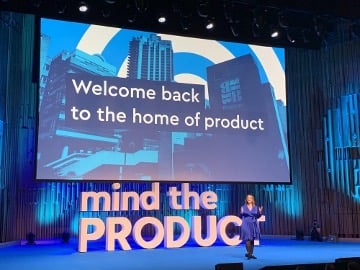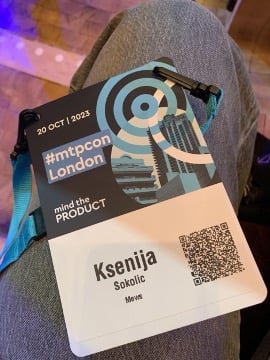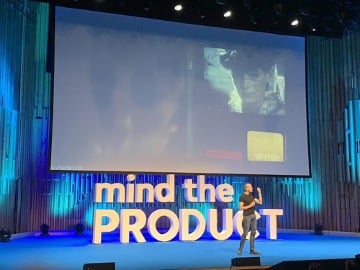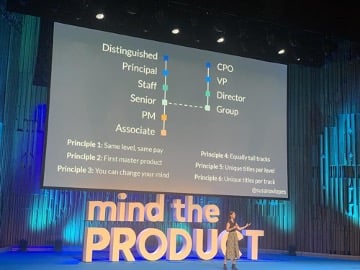Table of contents
The Mind the Product community will always hold a special place in my Product Manager (PM) career. As a PM in Croatia working for a Croatian company 6-7 years ago, there wasn’t much knowledge in product management available locally. Croatians are great entrepreneurs and founders (just think of Rimac, Photomath, or Nanobit) but didn’t have a history of doing product management; that knowledge just didn’t exist. I wasn’t schooled to be a PM (not sure anyone was a few years back), but the profession intrigued me, so I looked online to gather valuable resources and find communities where I could learn and craft the discipline.
I found many, but Mind the Product is the only one that stuck. It continues to be at the forefront of modern product practices, is constantly challenging the state of product, and forces us to look further and be better at what we do.

So, for years, I wanted to attend the Mind the Product conference in London. Then the pandemic happened, everything moved online, and it became questionable if the need to visit conferences in person still exists. Let’s be honest: you can get all that information online.
Well, this year's #mtpcon London proves it’s still worth it. Everyone who works in product nowadays can testify to how crazy it is with the rise of GenAI and the challenging economic situation, and being part of a scale-up like Mews doesn't make it any easier. Add to that two young children at home, and you easily end up in a situation where it’s extremely hard to take a step back and reflect on what and how you are doing.

For me, that’s the main benefit of in-person conferences. You force yourself to switch off and absorb everything the inspiring speakers have prepared (and #mtpcon always has a fantastic lineup). You reflect on how to implement this knowledge into your process and practices, realize everyone makes mistakes and you’re actually not that bad at what you do, exchange ideas with other PMs across countries and industries, and just enjoy the energy and potential in the room.
And #mtpcon London is that kind of conference. You get some practical frameworks, but most of all, you get inspired to rethink where you’re driving your product, question if things could be done better or which battles aren’t worth fighting, recognize why you’re doing what you’re doing, recharge, and then move forward smarter.
Main takeaways
These are the five primary quotes everyone should think about deeply from this year’s #mtpcon London:
- Tim Harford: “It’s not enough to replace the steam engine with the electric dynamo."
- Nilan Peiris: “Customers don’t care about autonomous teams. They care about the speed with which we achieve our mission.”
- Susana Videira Lopes: “Are you climbing someone else’s ladder?
- Marc Abraham: “If you want to increase your success rate, double your failure rate.”
- Claire Woodcock: “It doesn’t matter that you are using this fancy technology. What problem are you solving?”
Continue reading to get more insights from two (totally different) talks that intrigued me the most...
1. What we got wrong about technology, by Tim Harford
Tim Harford is a world-renowned behavioural economist, award-winning Financial Times columnist, data detective, BBC broadcaster, and much more, as you can learn from the #mtpcon speakers page.

It was fascinating to hear about the impact technological innovation has on people's lives and the economy from someone outside our nerdy RnD world.
It’s hard to paraphrase the compelling story Tim presented. If you have a chance, check out his presentation online, but here are a few main takeaways we can implement in our daily product life.
Don’t only focus on the most complicated problems
We shouldn’t focus exclusively on the most sophisticated technology and complex problems.
Tim illustrated this notion using Blade Runner, a famous Sci-Fi movie filmed in 1982 with the plot set in the distant future of 2019. In this predicted future, there’s space travel and very advanced artificial human beings that are almost indistinguishable from real ones. Despite all the fictional advanced technology, the writers couldn’t envision mobile phones, so Rick had to use a phone booth to make a call. Since it’s the future, it’s a video call, but the phone booth looks like it did in 1982.
Price matters
The world doesn't change when technology is invented, but once it becomes accessible to the masses. What changes the world are cheap technologies that are accessible to everyone, not the most sophisticated advancements.
A great example that proves this is the usage of solar power plants. While solar power plant technology has existed and been in use for decades, it wasn’t until the price dropped significantly that it impacted people's lives.
Technology isn’t enough
The third takeaway is that besides having the technology, we also need organizational and societal change. As an example, when the electric dynamo was invented, the first few factories that used it didn’t see a big difference in their factory efficiency compared to the steam engine they had used until then. That was because they didn’t change anything in the way they worked; they just replaced one engine with another. It was only during WWI when, due to worker shortages, factory managers had to think of new approaches to work that the electric dynamo gained traction as it could be used in ways that steam engines couldn’t.
Always consider the wider context
I can draw a parallel with the product we are building, a mobile restaurant management solution. The hospitality industry is quite a conservative (and complex) domain, and a high percentage of restaurants still use on-premises POS solutions. That means servers take guest orders on paper and then manually input them into a central terminal. Mobile POS enables servers to have their own devices, input orders directly into the system, and communicate with the kitchen instantly. This streamlines operations and minimizes errors.
When appropriate, guests can use QR codes for self-service and place orders directly with the kitchen. But if our customers buy our mobile POS that runs on an Android tablet, install it on a stand, and continue using pen and paper for order entry on that tablet, our technology is wasted. They could achieve similar results with their old system.
There is a serious staff shortage in today’s hospitality industry, and it will force managers to rethink how they can be more efficient and how existing technology can help them achieve higher revenue without expanding their workforce. We expect organizational change to occur as a consequence.
What we need to be careful about from the product side is how we are pricing our solution so that it encourages that change rather than limiting it.
2. Embracing a dual-track career ladder in product, by Susana Lopes
Susana is a B2B product management leader with over 10 years of experience working in scale-ups. This includes six years at Onfido, where she fought identity fraud by launching multiple award-winning machine learning products while growing year-on-year revenue by 10-fold. You can learn more from the #mtpcon speakers page.

In her engaging talk, Susana introduced dual career ladder tracks in product management. Despite many years in the field, this was the first time I’d heard this idea. The examples I’m familiar with suggest that to advance your PM career, you need to start managing other people, which implies that you stop building products. As you climb the career ladder, you work more on a strategic level and lead more people, but lose touch with daily product handling and all the small decisions that significantly impact the final success of your product.
It’s a well-known problem in the engineering world, and over time, it has become the norm for engineers to decide if they want to pursue their career in the management track or continue developing their technology expertise. So why shouldn’t a similar approach apply to product managers?
The main obstacle lies in companies recognizing this so you can still prosper if you decide you want to master your product management skills but don’t want to manage other people. This opens up an entirely new world of possibilities for product managers but also solves problems for companies.
Product managers and product directors are intensely focused on achieving their team's long-term KPIs and are biased toward products they have nurtured for months or even years. When it comes to looking outside the box or achieving cross-tribe initiatives, having someone neutral who is not biased towards their product is invaluable; someone with a deep understanding of the entire product suite, the market, and the customer base, along with well-crafted product skills. This ensures that products aren’t just delivered on time but also solve underlying problems. That person is none other than the Staff/Principal PM.
And Susana doesn't just pitch the idea – she shares an actionable framework with models and archetypes so you can see which option is the best fit for your culture. It's definitely something every company should take a look at. The presentation is available on her web page.
Final thoughts
Based on anonymous voting on #mtpcon, it seems I’m not the only one struggling to find time for education and learning. Use your time in the next few weeks wisely and sign up for free to receive all the #mtpcon recordings.

Author
Ksenija Kordi Sokolic
Ksenija is a Product Manager at Mews.

Essential hotel technology for general managers
Download now
Hospitality hot takes straight to your inbox


.webp)